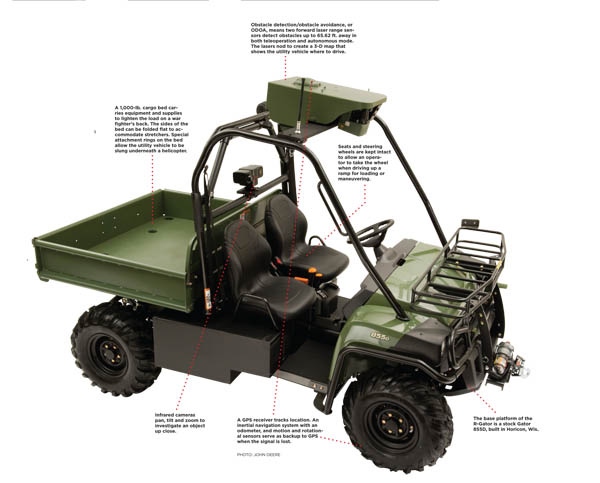March 17, 2014

If you’re a gamer and have played war games like “Halo” or “America’s Army,” then you’re already partially trained to operate the R-Gator, John Deere’s autonomous utility vehicle used in the U.S. military.
This year marks the 10th anniversary of this cyber war hero, commissioned in 2004 in response to the U.S. military’s call for a robot big enough to carry smaller robots used to disarm roadside bombs. Since then, the robotic Gator’s use has extended to anything the military defines as dull, dirty or dangerous.
“The best way I can put it is, we try not to replace a person with a robot, but to allow the war fighters to do more higher-value tasks and use the R-Gator to do the things like perimeter control or carrying supplies,” says Mark Bodwell, manager of the military utility vehicle business with John Deere.
Some of its high-profile customers?
SPAWAR, or Space and Naval Warfare Systems Command, uses the R-Gator for perimeter security 24 hours a day, seven days a week.
NASA bought the R-Gator as a surrogate for its lunar space probe to use on the ground to connect to attachments.
The British military’s Minister of Defense awarded John Deere the assisted carriage system contract to transport water, ammunition and other supplies to take the load off war fighters, extending missions from three days to five days.
The R-Gator is not sold on the farm market yet, but many of its components were derived from John Deere’s agriculture and turf division, making the transition to autonomy just a step away in agriculture.
For example, John Deere tractors already can turn at the end of rows by themselves and follow a combine with a grain cart. The company experimentally used its robotic greens mower to mow the baseball stadiums of the Arizona Diamondbacks and the Durham Bulls. And in Europe, John Deere sells a robotic mower named Tango.
Market demand will dictate further applications, Bodwell says. Price also will be a factor. After all, not everyone can afford an $80,000 to $1 million robot (price dependent on the number of sensors).
Here’s what’s required to get from cornfield to war field as an R-Gator.
For more information, visit deere.com.
Features
A CANbus wiring system underneath the hood provides for electronic control over mechanical functions such as steering, braking and shifting. A mechanical overdrive kicks in in the event of a systems failure.
Two antennas, mounted on top, allow for radio communication.
The vehicle can operate in four modes: autonomous, remote control, telops (telemetry online processing system) or manual. A teach and playback function, located on the dash and on the operator control unit, allows the operator to teach the vehicle to run different routes.
Batteries and onboard computers are stored in a box in front of the rear wheels.
The engine is military-certified and works with JP-8 military aviation fuel.
Like what you’re reading? Subscribe to Farm Industry News Now e-newsletter to get the latest news and more straight to your inbox twice weekly.
About the Author(s)
You May Also Like




